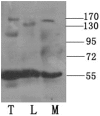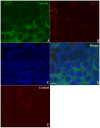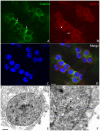KIFC1-like motor protein associates with the cephalopod manchette and participates in sperm nuclear morphogenesis in Octopus tankahkeei
- PMID: 21187923
- PMCID: PMC3004946
- DOI: 10.1371/journal.pone.0015616
KIFC1-like motor protein associates with the cephalopod manchette and participates in sperm nuclear morphogenesis in Octopus tankahkeei
Abstract
Background: Nuclear morphogenesis is one of the most fundamental cellular transformations taking place during spermatogenesis. In rodents, a microtubule-based perinuclear structure, the manchette, and a C-terminal kinesin motor KIFC1 are believed to play crucial roles in this process. Spermatogenesis in Octopus tankahkeei is a good model system to explore whether evolution has created a cephalopod prototype of mammalian manchette-based and KIFC1-dependent sperm nuclear shaping machinery.
Methodology/principal findings: We detected the presence of a KIFC1-like protein in the testis, muscle, and liver of O. tankahkeei by Western Blot. Then we tracked its dynamic localization in spermatic cells at various stages using Immunofluorescence and Immunogold Electron Microscopy. The KIFC1-like protein was not expressed at early stages of spermatogenesis when no significant morphological changes occur, began to be present in early spermatid, localized around and in the nucleus of intermediate and late spermatids where the nucleus was dramatically elongated and compressed, and concentrated at one end of final spermatid. Furthermore, distribution of the motor protein during nuclear elongation and condensation overlapped with that of the cephalopod counterpart of manchette at a significant level.
Conclusions/significance: The results support the assumption that the protein is actively involved in sperm nuclear morphogenesis in O. tankahkeei possibly through bridging the manchette-like perinuclear microtubules to the nucleus and assisting in the nucleocytoplasmic trafficking of specific cargoes. This study represents the first description of the role of a motor protein in sperm nuclear shaping in cephalopod.
Conflict of interest statement
Figures








Similar articles
-
The C-terminal kinesin motor KIFC1 may participate in nuclear reshaping and flagellum formation during spermiogenesis of Larimichthys crocea.Fish Physiol Biochem. 2017 Oct;43(5):1351-1371. doi: 10.1007/s10695-017-0377-9. Epub 2017 May 23. Fish Physiol Biochem. 2017. PMID: 28534180
-
Molecular cloning and characterization of KIFC1-like kinesin gene (ot-kifc1) from Octopus tankahkeei.Comp Biochem Physiol B Biochem Mol Biol. 2010 Jul;156(3):174-82. doi: 10.1016/j.cbpb.2010.03.004. Epub 2010 Mar 19. Comp Biochem Physiol B Biochem Mol Biol. 2010. PMID: 20304088
-
The expression pattern of the C-terminal kinesin gene kifc1 during the spermatogenesis of Sepiella maindroni.Gene. 2013 Dec 10;532(1):53-62. doi: 10.1016/j.gene.2013.09.008. Epub 2013 Sep 12. Gene. 2013. PMID: 24035901
-
Formation and function of the manchette and flagellum during spermatogenesis.Reproduction. 2016 Apr;151(4):R43-54. doi: 10.1530/REP-15-0310. Epub 2016 Jan 20. Reproduction. 2016. PMID: 26792866 Review.
-
Intramanchette transport (IMT): managing the making of the spermatid head, centrosome, and tail.Mol Reprod Dev. 2002 Sep;63(1):1-4. doi: 10.1002/mrd.10179. Mol Reprod Dev. 2002. PMID: 12211054 Review.
Cited by
-
Molecular characterization and expression analysis of a KIFC1-like kinesin gene in the testis of Eumeces chinensis.Mol Biol Rep. 2013 Sep 29. doi: 10.1007/s11033-013-2779-9. Online ahead of print. Mol Biol Rep. 2013. PMID: 24078165
-
Functional Analysis of KIF3A and KIF3B during Spermiogenesis of Chinese Mitten Crab Eriocheir sinensis.PLoS One. 2014 May 28;9(5):e97645. doi: 10.1371/journal.pone.0097645. eCollection 2014. PLoS One. 2014. PMID: 24870586 Free PMC article.
-
Sperm Differentiation: The Role of Trafficking of Proteins.Int J Mol Sci. 2020 May 24;21(10):3702. doi: 10.3390/ijms21103702. Int J Mol Sci. 2020. PMID: 32456358 Free PMC article. Review.
-
The C-terminal kinesin motor KIFC1 may participate in nuclear reshaping and flagellum formation during spermiogenesis of Larimichthys crocea.Fish Physiol Biochem. 2017 Oct;43(5):1351-1371. doi: 10.1007/s10695-017-0377-9. Epub 2017 May 23. Fish Physiol Biochem. 2017. PMID: 28534180
-
KIFC1 is essential for normal spermatogenesis and its depletion results in early germ cell apoptosis in the Kuruma shrimp, Penaeus (Marsupenaeus) japonicus.Aging (Albany NY). 2019 Dec 29;11(24):12773-12792. doi: 10.18632/aging.102601. Epub 2019 Dec 29. Aging (Albany NY). 2019. PMID: 31895691 Free PMC article.
References
-
- Hess RA, Renato FL. Spermatogenesis and cycle of the seminiferous epithelium. Adv Exp Med Biol. 2008;636:1–15. - PubMed
-
- Hermo L, Pelletier RM, Cyr DG, Smith CE. Surfing the wave, cycle, life history, and genes/proteins expressed by testicular germ cells. Part 1: background to spermatogenesis, spermatogonia, and spermatocytes. Microsc Res Tech. 2010a;73:241–278. - PubMed
-
- Gimenez-Bonafé P, Ribes E, Zamora MJ, Kasinsky HE, Chiva M. Evolution of octopod sperm I: comparison of nuclear morphogenesis in Eledone and Octopus. Mol Reprod Dev. 2002;62:357–362. - PubMed
-
- Hermo L, Pelletier RM, Cyr DG, Smith CE. Surfing the wave, cycle, life history, and genes/proteins expressed by testicular germ cells. Part 2: changes in spermatid organelles associated with development of spermatozoa. Microsc Res Tech. 2010b;73:279–319. - PubMed
-
- Dadoune JP, Siffroi JP, Alfonsi MF. Transcription in haploid male germ cells. Int Rev Cytol. 2004;237:1–56. - PubMed
Publication types
MeSH terms
Substances
LinkOut - more resources
Full Text Sources

